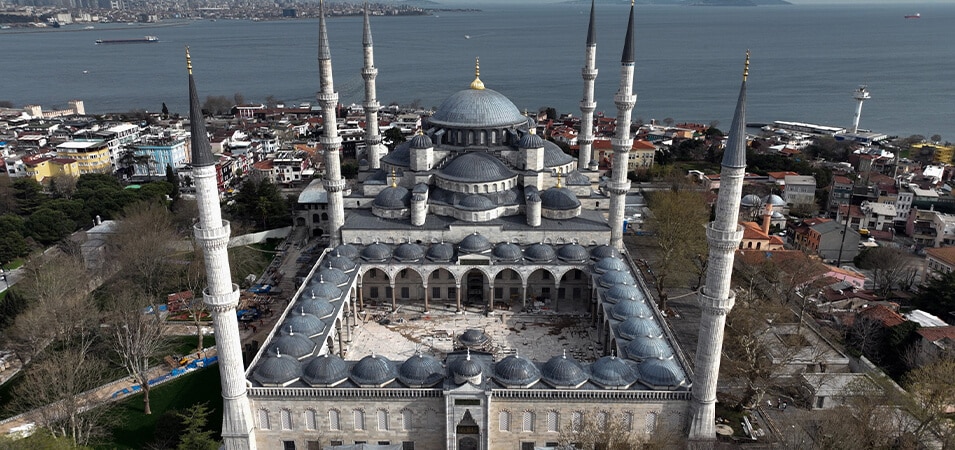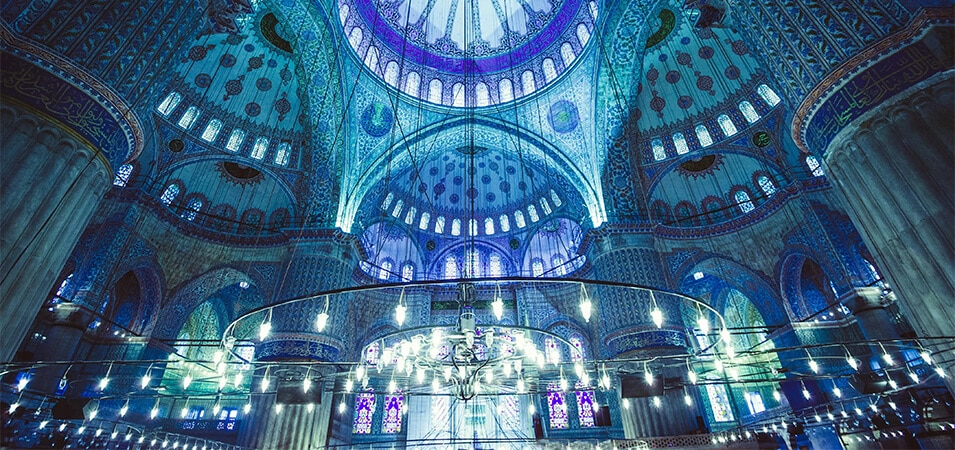The Blue Mosque, also called the Sultan Ahmed Mosque, is a beautiful piece of architecture that stands tall in the busy city of Istanbul in Turkey. In Islamic art and culture, this famous building has a special place. The Blue Mosque, built in the early 1600s, shows how grand and elegant Ottoman buildings can be.
The mosque’s name comes from the beautiful blue tiles that decorate the inside, one of its most exciting things. The detailed tilework shows the skill of Islamic art through flower designs, geometric patterns, and writing. The great dome, the tall minarets, and the extensive grounds give tourists and pilgrims a feeling of awe and peace.
The Blue Mosque is more than just a beautiful building; it is also a sign of Istanbul’s long past and diverse culture. It shows how great the Ottoman Empire was and how much it added to Islamic design. It is still used as a mosque today, and people come from all over the world to see its fantastic beauty and pay tribute to its cultural importance. The Blue Mosque is a beautiful building that shows how great Islamic art and culture are in Istanbul.
Don’t Miss checking out our Turkey Tour Packages.
Historical and Cultural Significance
Historical Overview of Blue Mosque
The Blue Mosque, also called the Sultan Ahmed Mosque, was built between 1609 and 1616 during the rule of the Ottoman Empire. It was ordered to be built by Sultan Ahmed I. The architect Sedefkar Mehmed Aa created it by fusing elements of the Byzantine and Ottoman styles to produce a marvel. It was built to compete with the nearby Hagia Sophia and show that Sultan Ahmed I was a big supporter of the building.
Cultural Significance of Blue Mosque
- In the context of Istanbul’s rich history, the Blue Mosque has a lot of artistic importance. As one of the city’s most well-known symbols, it shows how Islamic, Byzantine, and Ottoman traditions came together. The building and design of the mosque show how good the artists of the Ottoman Empire were at putting together elaborate writing, geometric patterns, and flower themes.
- The Blue Mosque also signifies religious faith and a sense of togetherness. It is still used as a place of worship, with thousands of people going there for Friday prayers and other religious events. With its washing waterfalls and large size, the mosque’s garden gives guests a sense of unity and peace.
- Also, the Blue Mosque is a cultural bridge that brings in people from all over the world. It allows them to learn about Islamic art, architecture, and religion. People are amazed by the grandeur of the interior, which is covered with thousands of blue tiles that create a mesmerizing atmosphere. The mosque is not only a part of Istanbul’s skyline but also adds to the city’s image as a culturally rich place to visit.
- In conclusion, the Blue Mosque is historically and culturally significant because of its beautiful architecture, the way it shows the grandeur of the Ottoman Empire, its role as a place of worship and community, and its ability to bring people together through their appreciation of Islamic art and culture.

Architectural Features and Design Elements
The Blue Mosque is famous for its beautiful architecture and design, which show how the Ottoman and Byzantine styles work well together.
- Domes: The mosque has a central dome that stands out in the middle of the prayer hall. Smaller semi-domes circle it. Four massive piers hold the main crown, 23.5 meters (77 feet) in diameter and 43 meters (141 feet) high. The semi-domes on either side of the central dome give the building a sense of balance and beauty.
- Minarets: The Blue Mosque has six thin minarets, a rare and unique feature. Four of these minarets are at the ends of the mosque, and the other two are on either side of the door. The balconies and circular caps on top of the minarets add to the mosque’s elegant look.
- Tilework: The mosque’s interior has a beautiful show of blue Iznik tiles, which is how it got the name “Blue Mosque.” Floral designs, geometric patterns, and writing are carefully carved into the elaborate tilework by skilled artists. The tiles make the inside of the mosque more beautiful and give it a fascinating look.
- Architectural Fusion: The Blue Mosque represents a fusion of Ottoman and Byzantine architectural styles. The large central dome and the use of semi-domes are Ottoman design elements. In contrast, the building’s spiraling domes, pendentives, and large size are based on the nearby Hagia Sophia’s Byzantine architecture. This mix of styles makes a beautiful and culturally important look.
The beauty of the Blue Mosque’s design, with its giant domes, thin minarets, and detailed tilework, shows how brilliant its architects were and how well they knew Ottoman and Byzantine architectural styles. It is a true gem that continues to draw people in with its beauty and elegance.
Interior design of Blue Mosque
Grand Prayer Hall
The inside of the Blue Mosque is a treasure trove of beauty and glory. The large prayer hall and beautiful decorations draw people in.
- Prayer Hall: The prayer hall is a large room with high ceilings held by many columns and domes. The large dome overshadows the central area, which gives a feeling of awe and peace. The hall is enormous, so it has a lot of space and is quiet enough for many people to pray there.
- Decorative Elements: The interior of the Blue Mosque is filled with a wide variety of decorations that show how well Islamic art is done. Calligraphy is often used, one of the most noticeable ways to decorate. Verses from the Quran are written in beautiful Arabic on the mosque’s walls, arches, and domes. In Islamic art, calligraphy is a significant way to send spiritual messages and show how beautiful the written word is.
- Floral Motifs: Another striking thing about the interior of the Blue Mosque is how many floral designs there are. Intricate arrangements of flowers and plants are carefully woven into the tilework, making the room look beautiful and orderly. Floral themes reflect the beauty of nature and are often used in Islamic art to show the idea of heaven and the good things that came from the world’s creation.
With its large prayer hall and carefully made decorations, the Blue Mosque’s interior shows off the rich artistic history of Islamic culture. The handwriting and flower designs create a calm and spiritually reflective atmosphere. Visitors are amazed by the beautiful interior of the mosque, which is full of detailed artistry and deep meaning.

Visitor Experience of Blue Mosque
Seeing the Blue Mosque is a unique and rewarding experience that immerses people in the beauty and spirituality of Islamic art. But it’s essential to know the dress code and act correctly.
- Dress Code: Both men and women must wear modest clothes. Women should wear clothes that cover their shoulders, arms, legs, and heads. Men should wear long pants and stay away from shirts with no sleeves. People who need them can get robes and things to cover their heads at the door.
- Etiquette: The Blue Mosque is a place of prayer, so people there should be polite. It is essential to whisper, not make loud noises, and not take pictures with a flash. Before entering a mosque, you must take off your shoes and wash your hands and feet at the washing pools in the courtyard.
Blue Mosque: Practical Information
- Opening Hours: The Blue Mosque is open daily, except when it’s time to pray. Escaping prayer times and big groups in the morning or late afternoon is best.
- How to get in: The Blue Mosque is free, and you don’t need to make a ticket beforehand. It would help if you got there early to ensure you get in, especially during busy tourist times.
- Guided Tours: People who want to learn more about the mosque’s history, design, and cultural importance can go on a guided walk. These tours give visitors important information about the Blue Mosque and make their visit more enjoyable.
Visitors can have a polite and good time at the Blue Mosque if they follow the dress code, use proper manners, and know important information. It is a place where you can enjoy the beauty of Islamic art and find peace in the quiet of this sacred space.
Conclusion
The Blue Mosque is in the middle of Istanbul. It symbolizes the beauty of Islamic buildings and the city’s rich cultural history. With its giant domes, skinny minarets, and detailed tilework, the mosque has a stunning beauty that makes people gasp when they see it. It is a beautiful mix of Ottoman and Byzantine building styles that shows how talented the people who made it were.
The Blue Mosque is more than just a beautiful piece of architecture. It also reminds us of the Ottoman Empire’s greatness and contributions to Islamic art. As a place of prayer still used, it is a spiritual refuge that helps people feel closer together and more devoted.
Going to the Blue Mosque is a one-of-a-kind experience that mixes cultural learning, spiritual reflection, and awe-inspiring architecture. Stepping into its grand prayer hall and seeing the elaborate decorations is an awe-inspiring experience that should not be missed. It’s a chance to enjoy the beauty of Islamic art, learn more about Istanbul’s history, and feel the mosque’s deep sense of peace and reverence.
Don’t Miss checking out our Related Article :
